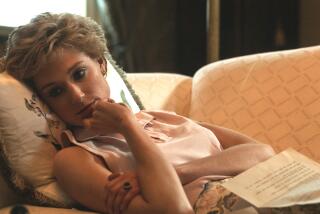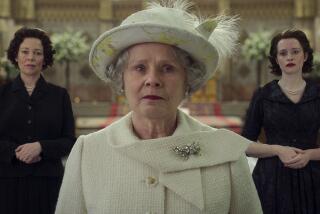‘She Was the People’s Princess’
- Share via
LONDON — “A perfect woman, nobly planned, to warn, to comfort and command, and yet a spirit still, and bright, with something of angelic light. Rest in peace, dear lady.” So read the handwritten note--quoting a William Wordsworth poem--tacked to the gate of Kensington Palace, home of Diana, the princess of Wales.
The fairy-tale princess is dead, and her realm--from the docks of east London to the dhows of East Africa--is ripped by a grief only the world’s most ordinary of extraordinary people could evoke.
For all her glamour, good looks and royal credentials, it was the aura of Diana the Ordinary--vulnerable, demure and exceptionally unassuming amid the pomp and circumstance--that separated her from the family Windsor and so endeared her around the globe.
“She was a wonderful and warm human being,” said British Prime Minister Tony Blair. “She was the people’s princess.”
From working-class Britons to Americans who watched the passing royal show with hungry interest, Diana’s death seems to have touched some chord. “Everyone I’ve spoken to today has been up all night,” said Lynda Resnick, the co-owner of the Franklin Mint, which spent $151,000 to buy one of Diana’s evening dresses at the highly publicized charity auction of her clothing at Christie’s in New York two months ago. “I didn’t sleep at all. I was so tormented by the senselessness of this.”
In Los Angeles, in front of the British Consulate on Wilshire Boulevard, people left flowers and candles, and a woman sat crying softly.
Certainly the violence and untimeliness of her death have something to do with the depth of worldwide reaction, but the extent of the sadness and the public expectation of a state funeral in Britain--no matter what the protocol is--only confirm the global appeal Diana commanded during her roughly 17 years on the public stage.
In an era of cynicism, Diana seemed to cast a spell on all: the flower-wielding well-wishers who waited behind barricades, the ill and infirm she visited in hospitals, the high and mighty who supped with her. Museum directors and fashion editors went giddy in her presence. Phil Donahue turned pink with pride when he danced with her at a Chicago event last year. Former Secretary of State Henry A. Kissinger beamed as he dined alongside her at a formal event a year or so ago.
Unflinching feminist Camille Paglia dissected the princess--”Diana’s behavior has an operatic Mediterranean theatricality,” she wrote in an essay--and waxed fondly about her too. At a televised gathering of feminists last year, Paglia was among those saluting Diana as a “female icon”--in the company of Eleanor Roosevelt, Jacqueline Kennedy and Marilyn Monroe, among others.
Diana as a Postmodern Icon
David Cannadine, a professor of history at Columbia University who has written about 19th and 20th century Britain, speculates that it was Diana’s embodiment of several images at once that made her so appealing.
“She was the postmodern multiple-identities icon,” Cannadine said. “Ingenue, devoted wife, thwarted wife, international sex symbol, international charity worker. And not just one to another in a single progression. One day, she’s romping on a yacht, the next day she’s doing work on land mines in Bosnia. Whether these images were really her or our imagination, I don’t know. She was Mother Teresa one day and Marilyn Monroe the next. And it was irresistible to some.”
Outside the gilded gates to her palace Sunday, as thousands of mourners from Britain and abroad laid flowers 4 feet deep, the softly spoken and often teary tributes were directed at the Diana who embodied several of the images that people had come to embrace: Diana the loving mother, Diana the “queen of hearts,” Diana the goodwill ambassador and Diana the forsaken wife.
No one spoke of Diana the almost-queen.
“She was just a normal person, unlike anyone else in the royal family,” said Mary Poleon, 60, a retired railroad worker from east London. “No matter who you were, she shook your hand without a glove.”
Possessing an unremarkable education, wealthy by birth, Diana would probably have led a comfortably anonymous life had she not married Charles, the prince of Wales. But Diana turned out to be everything the fusty British royal family was not--warm, genial, engaging, unpretentious and beautifully dressed.
From ‘Shy Di’ to People’s Princess
The public had seen her in the last few years as a humanitarian, traveling the world, making passionate and pointed speeches--too pointed, some British politicians had recently said. They may have forgotten that during the first years of her marriage, she barely uttered a public word, too shy and nervous to make public speeches.
It didn’t matter. Her smile seemed genuine, her small talk sincere, her complexion English rose. Crowds who waited for the royal couple’s public appearances hoped that Diana, not Charles, would work their side of the barricade.
“It’s like she was someone in your family,” Phil Elwell said as he taped photographs of a smiling Diana in the front window of Santa Monica’s Ye Olde King’s Head Shoppe, the store that he and his wife have run for two decades. The store and adjoining restaurant are gathering spots for British expatriates. “She’s part of everybody, I guess, in Britain.”
“She was a commoner even though she wasn’t a commoner,” said Rodney Drake, 54, a cabdriver at London’s Heathrow Airport who took upon himself the grim task of informing passengers of the princess’ death as they drifted from the terminal. “She brought glamour and life and down-to-earthness to the royal family.”
For American society, which, lacking a royal family, elevates Hollywood celebrities and a few politicians to that status, Diana seemed a melding--of the credentials of a princess with the looks and charisma of a movie star.
A Devoted Modern Mother
It only helped her public standing everywhere that she appeared to be a devoted modern mother, not a princess who delegated her children to a staff of nannies (of whom she had plenty).
When her firstborn, William, was a baby and she was expected to travel on a long trip to Australia with Charles, she balked at leaving William behind and insisted that the baby travel with her and Charles, thus breaking the tradition of heirs to the throne not traveling together. As the children grew, she was pictured as a hands-on mother, taking her children to amusement parks and on ski trips.
In the end, she was modern in her troubles as well. She had a modern young woman’s disease--bulimia. She reacted to her husband’s reported coldness and long-standing love for another woman in a modern way too--she got a divorce. An illicit affair with a riding instructor was detailed in a book.
She grew more outspoken and more comfortable speaking in public. In November 1993, during a time of rampant media reports on her bulimia, she started a speech to one group by wryly observing: “I think you are very fortunate to have your patron here today. I was supposed to have my head down the loo. I’m supposed to be dragged off the minute I leave here by men in white coats.”
It’s unlikely that she won over any staunch anti-royalists. And she was never without her critics. Only a few years into her marriage came the cries that she was little more than an airhead spendthrift with too many clothes--a charge that annoyed her greatly. (She claimed that the clothes were required for her job.) It’s not surprising that when she finally decided to get rid of 79 elaborate gowns and cocktail dresses at the Christie’s auction and give all the proceeds to charity, she chose America--where money and adoration for her flow more freely.
She came in for some harsh criticism toward the end of her marriage. At one point, she was described as a “loose cannon” by British authorities. At a particularly low moment, her husband’s friends indicated that she was mentally disturbed and should be institutionalized. And since her 1992 separation from her husband, she had sometimes seemed more a neurotic young woman with poor taste in men than a gleaming icon. She reportedly became too fond of a married rugby star at one point. She reportedly telephoned another man incessantly during one lonely period in her life.
Despite ups and downs in her public ratings, however, on balance, her vulnerability only won her greater admiration.
“Two things stand like stone,” a young Princess Diana said prophetically in a speech in the 1980s. “Kindness in another’s trouble; courage in your own.”
To Britain, With Love
In a 1995 TV interview, when she acknowledged for the first time many of her own failings, Diana said: “The British people need someone in public life to give affection, to make them feel important, to support them, to give them light in their dark tunnels. . . . Yes, I have had difficulties, as everybody has witnessed over the years, but let’s now use the knowledge that I have gathered to help other people in distress.”
Washington attorney Heather Thomas, 28, who traveled to New York for the dress auction, said she had been intrigued by the Diana who struggled to reinvent herself.
“It wasn’t the clothes or the fact that she married the heir to the throne. My fascination began when her marriage started to fall apart,” Thomas said. “She had so many expectations placed on her; she was struggling to find herself and present that reality to the world whether it liked that or not. And I think that’s something any woman can relate to.”
Thomas watched the 1981 wedding on television only because her mother dragged her out of bed to do so. “My mother said, ‘You’re going to want to be able to say you woke up for the prince and princess of Wales’ wedding.’ ”
Cannadine, the Columbia history professor, argues that in the last month or so in Britain, people may not have been so favorably disposed to her as she engaged in a relationship with Dodi Fayed.
“People were beginning to sell shares in Diana and buy shares in Charles and Camilla. She seemed to be kind of losing it. She seemed to find happiness with Dodi, but this wasn’t considered an altogether seemly way for the mother of the future king to behave,” Cannadine said.
Diana’s death will no doubt fix her public image at its most revered point. Said Lynda Resnick: “She will never age. She will always remain beautiful and perfect in our memory.”
Murphy reported from London and Hall from Los Angeles. Times staff writer Bettina Boxall and special correspondent Claire Vitucci also contributed to this report.
More to Read
Sign up for Essential California
The most important California stories and recommendations in your inbox every morning.
You may occasionally receive promotional content from the Los Angeles Times.














